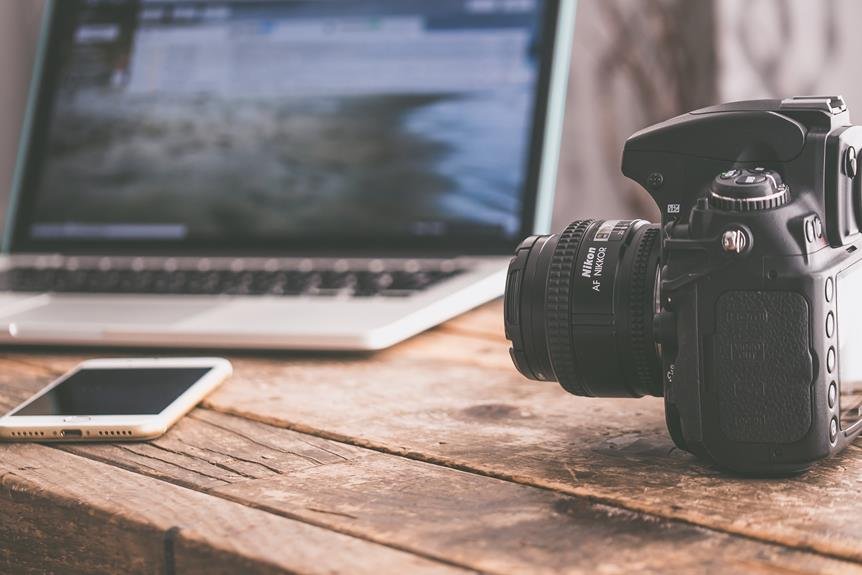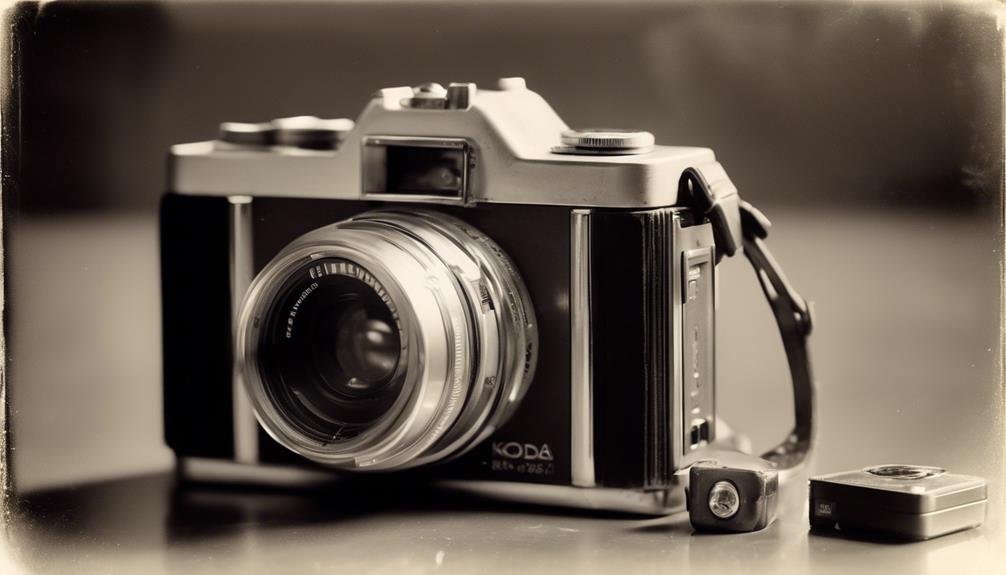
We all strive for seamless, effortless connectivity when it comes to our cameras and wireless devices. But achieving that can sometimes be a perplexing ordeal. From understanding the intricacies of various wireless standards to troubleshooting connectivity issues, there are numerous factors to consider. In today's tech-centric world, a solid grasp of how to optimize camera wireless connectivity is essential for capturing and sharing moments efficiently. So, let's explore 13 key tips that can elevate your camera's wireless capabilities and streamline your photography workflow.
Understanding Wireless Standards
Let's delve into the world of wireless standards and understand the key aspects that impact camera wireless connectivity. When it comes to wireless connectivity for cameras, two crucial factors to consider are encryption protocols and network coverage. Encryption protocols are essential for securing the data transmitted between the camera and the connected devices. It's important to ensure that the camera supports strong encryption standards such as WPA2 or WPA3 to prevent unauthorized access to the footage.
In addition to encryption protocols, network coverage plays a vital role in ensuring seamless connectivity for the camera. The camera should be compatible with the latest Wi-Fi standards to provide a stable and reliable connection, especially in environments with multiple wireless devices. It's also beneficial to consider cameras that support dual-band Wi-Fi, as it offers the flexibility to connect to different networks based on availability and interference.
Wi-Fi Network Setup
Let's start by ensuring that your network security settings are in place to protect your data. We'll then move on to optimizing the signal strength to ensure a stable and consistent connection. And finally, we'll cover troubleshooting common Wi-Fi issues that may arise during the setup process.
Network Security Settings
When setting up your Wi-Fi network, it is essential to configure the network security settings to ensure a secure and reliable connection for your camera's wireless connectivity. To enhance network security and data encryption for your camera's wireless connectivity, consider the following key tips:
- Use WPA3 Encryption**: Utilize the latest Wi-Fi Protected Access (WPA3) encryption standard to safeguard your network from unauthorized access and protect your data from potential threats.
- Enable MAC Address Filtering: Restrict network access to only specified devices by enabling MAC address filtering, adding an extra layer of security to your wireless network.
- Change Default Network Name (SSID)**: Modify the default network name (SSID) to a unique and non-identifiable name to prevent potential hackers from identifying your network and attempting unauthorized access.
Signal Strength Optimization
To optimize the signal strength for your Wi-Fi network setup, consider strategically placing the router in a central location within your home or office. This helps minimize signal interference and ensures a more even distribution of Wi-Fi coverage. Additionally, positioning the router away from obstructions such as walls, metal objects, and electronic devices can further enhance signal strength. For larger areas, utilizing range extension devices like Wi-Fi repeaters or extenders can effectively broaden the coverage area. These devices amplify the existing signal and rebroadcast it, extending the range of the Wi-Fi network. By carefully managing the placement of your router and employing range extension solutions, you can significantly improve the overall signal strength and quality of your wireless connection, enhancing the performance of your camera's wireless connectivity.
Troubleshooting Wi-Fi Issues
As we troubleshoot Wi-Fi issues related to the network setup, it's crucial to ensure that the router is optimally positioned and free from obstructions to maintain a strong and reliable wireless connection for your camera. When troubleshooting network issues, consider the following Wi-Fi troubleshooting techniques:
- Router Placement: Position the router in a central location and elevate it to minimize interference and maximize coverage.
- Signal Interference: Identify and eliminate potential sources of signal interference, such as other electronic devices or physical barriers.
- Network Security: Ensure that the Wi-Fi network is secure by using strong passwords and encryption to prevent unauthorized access.
Bluetooth Pairing Process
We found the Bluetooth pairing process to be straightforward and efficient, allowing us to connect our camera to external devices with ease. When it comes to Bluetooth device compatibility, it's essential to ensure that the camera and the external device you want to pair it with are both Bluetooth-enabled and support the same Bluetooth profiles. This ensures seamless connectivity and functionality. In case of any issues, troubleshooting can involve simple steps such as ensuring that both devices are within the Bluetooth range, which is typically around 30 feet, and that there is no interference from other electronic devices. Additionally, ensuring that both devices have sufficient battery power can also help resolve pairing problems. To avoid interference, it's essential to keep the camera and the paired device away from sources of interference such as other wireless devices, microwaves, or dense physical barriers. By following these steps, we were able to pair our camera with various devices effortlessly, enhancing our overall photography experience.
NFC for Quick Connections

After smoothly pairing our camera with external devices using Bluetooth, we can now explore the convenience of NFC for quick connections. NFC technology enables seamless connections with compatible devices, allowing for fast data transfer and secure communication. Here are three key benefits of using NFC for camera connectivity:
- Instant Pairing: With NFC, you can simply tap your camera against another NFC-enabled device to establish a connection. This eliminates the need for manual pairing processes, making it incredibly quick and user-friendly.
- Effortless File Transfer: NFC facilitates rapid data transfer between your camera and other devices, such as smartphones or tablets. This means you can swiftly share photos and videos without the hassle of cables or complicated setup procedures.
- Enhanced Security: NFC connections are encrypted, ensuring secure communication between devices. This feature provides peace of mind when transferring files or remotely controlling your camera.
NFC technology offers a streamlined approach to establishing connections, making it a valuable tool for photographers seeking efficient and reliable wireless connectivity.
Utilizing Mobile Apps
We've found that utilizing mobile apps can greatly enhance the functionality of our cameras. Many modern cameras are designed to work seamlessly with specific mobile apps, allowing for easy transfer of photos and videos. These apps also provide remote control options, giving us the flexibility to capture amazing shots from a distance.
App Compatibility
When using mobile apps for camera wireless connectivity, it's essential to ensure compatibility with your specific device and operating system to maximize functionality and performance. App compatibility is crucial for seamless integration and optimal user experience. Here's what to consider:
- Operating System Compatibility: Ensure that the app is compatible with your device's operating system (iOS, Android, etc.) to access all features.
- Device Limitations: Be aware of any hardware or software limitations on your device that may affect the app's performance, such as older model devices or limited storage capacity.
- App Updates: Regularly check for updates to the app to ensure ongoing compatibility with your device and access new features and improvements.
Remote Control Options
Considering the importance of app compatibility for seamless wireless connectivity, let's now explore the various remote control options available through mobile apps. Smartphone compatibility is a key feature to look for when choosing a mobile app for remote control of your camera. These apps allow for easy access to settings, focus control, and even shutter release from your smartphone. Additionally, some apps offer the option to connect wireless remotes for added convenience and flexibility in controlling your camera. For users looking to extend the range of their remote control, signal boosters can be a valuable addition. These devices enhance the connectivity and range of the wireless signal, allowing for greater flexibility and control over your camera. By utilizing these remote control options through mobile apps, photographers can elevate their shooting experience to new heights.
Remote Shooting Techniques

Using a smartphone or tablet, photographers can wirelessly control their camera's settings and capture images from a distance, enhancing their creative possibilities and allowing for unique perspectives. Remote shooting techniques offer numerous benefits, including:
- Enhanced Control: With compatible cameras, photographers can adjust settings like aperture, shutter speed, and ISO remotely, providing greater flexibility and control over the final image.
- Creative Perspectives: Remote shooting allows photographers to capture unique angles and perspectives that would be difficult or impossible to achieve with traditional shooting methods, leading to more innovative and compelling compositions.
- Convenience and Efficiency: By being able to trigger the shutter remotely, photographers can minimize camera shake and capture candid moments more discreetly, making the entire shooting process more efficient and convenient.
These techniques not only expand the creative possibilities for photographers but also streamline the process, making it easier to capture stunning images. Camera compatibility is essential when exploring remote shooting benefits, as not all cameras offer wireless control options. By leveraging remote shooting techniques, photographers can elevate their work and push the boundaries of their creativity.
Image Transfer Methods
Let's talk about the different methods for transferring images wirelessly from your camera. Direct Wi-Fi transfer and Bluetooth connectivity are two popular options that offer convenience and speed. With these methods, you can quickly and easily transfer your photos from your camera to your smartphone or computer for editing and sharing.
Direct Wi-Fi Transfer
Exploring direct Wi-Fi transfer for image sharing provides a convenient and efficient method for transmitting photos and videos wirelessly between devices. When considering Wi-Fi direct, it's important to weigh the benefits such as faster transfer speeds, direct connection without the need for a router, and lower power consumption against the drawbacks of limited range and compatibility issues. In comparison to other direct transfer alternatives, Wi-Fi direct offers a seamless and quick way to share media files without the need for cables or internet access. Additionally, it provides a reliable option for transferring large files, making it a preferred choice for many photographers and videographers. With these advantages in mind, understanding how to utilize Wi-Fi direct for image transfer can significantly enhance the efficiency of your workflow.
Bluetooth Connectivity
After exploring the benefits of Wi-Fi direct transfer, we can now shift our focus to Bluetooth connectivity as another method for transferring images wirelessly between devices. Bluetooth offers a convenient way to transfer photos from your camera to a smartphone or tablet. It's ideal for quick, short-range transfers, making it perfect for on-the-go sharing. With an average range of about 30 feet, Bluetooth connectivity allows for seamless image transfer without the need for an internet connection. When considering Bluetooth, it's essential to ensure device compatibility to guarantee smooth and efficient image transfers. Most modern cameras and smartphones are equipped with Bluetooth capabilities, making it a widely accessible option for wireless image transfer. Understanding Bluetooth range and device compatibility can help streamline your photography workflow, allowing for easy and efficient image sharing.
Cloud Integration Options

Consider incorporating your camera's cloud integration options to securely store and access your footage from anywhere. Cloud integration offers numerous benefits, including seamless access to your footage, data encryption for enhanced security, and easy sharing and collaboration with others. Here are three key reasons why cloud integration is a game-changer for camera wireless connectivity:
- Secure Cloud Storage: Cloud integration allows you to store your footage in a secure, off-site location, protecting it from physical damage or theft. This ensures that your valuable data is safe and easily accessible whenever you need it.
- Advanced Data Encryption: Many cloud integration options provide robust data encryption to safeguard your footage from unauthorized access. This advanced security feature gives you peace of mind knowing that your footage is protected against potential cyber threats.
- Effortless Access and Sharing: With cloud integration, you can conveniently access your footage from any device with an internet connection. Additionally, you can easily share your footage with colleagues or collaborators, streamlining the collaborative workflow.
Incorporating cloud integration options into your camera's wireless connectivity empowers you with secure, convenient, and reliable access to your valuable footage.
Firmware and Software Updates
As we shift our focus to 'Firmware and Software Updates', ensuring that your camera's cloud integration is up-to-date is crucial for maintaining the security and functionality of your wireless connectivity system. Regular firmware and software updates are essential to enhance network stability and strengthen data security. These updates often include bug fixes, performance improvements, and security patches that help safeguard your camera system against potential vulnerabilities. By keeping your camera's firmware and software current, you can ensure that it operates smoothly within your network environment, reducing the risk of connectivity issues and potential security breaches.
Firmware and software updates also often introduce new features and capabilities, allowing your camera to stay ahead of evolving technology trends. It's important to regularly check for updates from your camera's manufacturer and install them as soon as they become available to take advantage of the latest advancements in wireless connectivity and security protocols. Additionally, many updates are designed to optimize the performance of your camera system, resulting in improved overall functionality and user experience. Be proactive in maintaining the firmware and software of your camera to ensure a reliable and secure wireless connectivity experience.
Troubleshooting Connectivity Issues

If you're experiencing connectivity issues with your wireless camera, performing a thorough diagnostic check can help identify and resolve the underlying problems. Here are some key steps for network and connectivity troubleshooting:
- Check Network Settings: Ensure that your camera is connected to the correct Wi-Fi network and that the network is functioning properly. Double-check the network password and verify that the camera is within the range of the Wi-Fi signal.
- Update Firmware: Check for the latest firmware updates for your camera. Outdated firmware can sometimes cause connectivity issues, and updating it may resolve the problem.
- Interference Identification: Identify potential sources of interference such as other electronic devices, thick walls, or metal objects between the camera and the router. Repositioning the camera or the router can help improve connectivity.
When troubleshooting connectivity issues, it's important to systematically work through potential problem areas to identify and resolve the root cause. By following these steps, you can improve the wireless connectivity of your camera and ensure a seamless experience.
Securing Wireless Connections
After troubleshooting connectivity issues, ensuring the security of your wireless connections is essential for safeguarding your camera and maintaining privacy. Implementing robust wireless encryption and network authentication protocols is crucial to prevent unauthorized access and protect your data. Here are some key tips for securing your wireless connections:
| Wireless Encryption | Network Authentication |
|---|---|
| Use WPA3 or WPA2 | Enable MAC address filtering |
| Create a strong, unique passphrase | Implement two-factor authentication |
| Regularly update encryption keys | Use strong, unique passwords |
| Disable WPS (Wi-Fi Protected Setup) | Utilize captive portals for guest networks |
| Consider using a virtual private network (VPN) for added security | Regularly monitor and audit network access logs |
Battery Saving Strategies

To optimize battery life for your camera, consider implementing power-saving settings and utilizing efficient shooting techniques. By doing so, you can ensure that your camera's wireless connectivity features, such as smartphone integration, remain operational for longer periods. Here are some power management techniques to help you extend the battery life of your camera:
- Use Airplane Mode: When not actively transferring files or controlling your camera remotely via a smartphone, switch your camera to airplane mode to reduce power consumption and extend battery life.
- Dim the Display: Lower the brightness of your camera's display or opt for a shorter display timeout to conserve power during periods of inactivity.
- Turn Off Wi-Fi When Not in Use: When you're not utilizing wireless connectivity features, such as transferring images to a smartphone or using remote shooting capabilities, disable the Wi-Fi function to prevent unnecessary power drain.
Implementing these battery-saving strategies can significantly enhance the longevity of your camera's battery, allowing you to capture and share moments without the interruption of a drained battery.
Enhancing Workflow Efficiency
Maximizing the efficiency of wireless connectivity features while conserving battery life is essential for enhancing workflow efficiency in photography. To achieve seamless workflow optimization and network reliability, it's crucial to utilize cutting-edge technology and best practices. One way to achieve this is by leveraging advanced wireless protocols such as Wi-Fi 6, which offers higher data throughput and improved network efficiency. Additionally, employing dual-band or tri-band wireless routers can help reduce network congestion and enhance overall network reliability, ensuring a smooth and uninterrupted workflow.
| Enhanced Workflow Efficiency | Benefits |
|---|---|
| Advanced Wireless Protocols | Higher data throughput |
| Dual-Band/Tri-Band Routers | Reduced network congestion |
| Network Reliability | Smooth and uninterrupted workflow |
Frequently Asked Questions
Can I Use the Camera's Wireless Connectivity to Connect to a Smart Home System or Home Automation Devices?
Absolutely, the camera's wireless connectivity seamlessly integrates with smart home systems and home automation devices. It enhances convenience and control, allowing us to effortlessly manage our home environment with innovative technology.
What Are the Potential Security Risks of Using Wireless Connectivity With My Camera and How Can I Protect Against Them?
We need to be aware of potential security risks when using wireless connectivity with cameras. We can protect against them by implementing data encryption, network monitoring, and strong authentication measures to safeguard our devices and data.
Can I Use the Camera's Wireless Features to Remotely Control and Adjust Settings on Other Photography Equipment, Such as Lighting or Tripods?
Yes, we can use the camera's wireless features to remotely control and adjust settings on other photography equipment, such as lighting or tripods. It enhances our flexibility and creativity during shoots.
Are There Any Limitations to the Range of the Camera's Wireless Connectivity, and How Can I Extend It if Needed?
We can extend the range of the camera's wireless connectivity by boosting signal strength with Wi-Fi extenders or using a dedicated camera wireless range extender. This allows for greater flexibility and creativity in photography.
Can I Use the Camera's Wireless Connectivity to Directly Print Photos to a Compatible Printer, and What Are the Requirements for Doing So?
Yes, we can use the camera's wireless connectivity for direct photo printing to a compatible printer. The requirements include printer compatibility and ensuring that both devices are connected to the same network.
